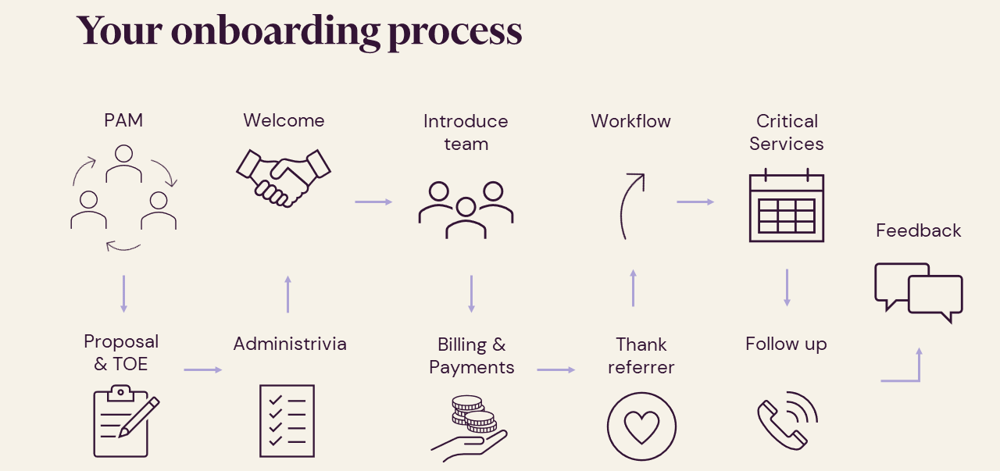Client Onboarding
Table of Contents
Key Onboarding ObjectivesThe 10 Steps to Client Onboarding
- The all-important first client meeting
- The proposal
- The administrivia
- Welcoming your client onboard
- Introduce key team members
- Billing and payments
- Thank the referrer!
- Set jobs up in workflow
- Deliver any 'time critical' jobs
- The one-month follow up call
Effective client onboarding is much more than getting authorities to act, updating your database, and assigning a team member to a job.
Client onboarding is your first opportunity to prove to new clients that they made the right choice when they chose your firm. It’s all about starting the relationship on a reliable, productive, positive, and engaging footing, leading to a better working relationship and more referrals!
Effective client onboarding is much more than getting authorities to act, adding information to your database, and assigning a team member to a job.
Client onboarding is your first opportunity to prove to new clients that they made the right choice when they chose your firm. It’s all about starting the relationship on a reliable, productive, positive, and engaging footing, leading to a better working relationship and more referrals!

Customer Centric Onboarding
When you deliver an on-brand, reliable and deeply engaging onboarding experience, you’ll improve your bottom line.
- You’ll generate new leads: New clients will rave about their experience to friends and family
- You’ll improve retention and increase profitability: Improving client retention by 5% can increase profitability by up to 25%
- You’ll increase average client spend: You’ve made it easier for them to do business with you
- Expectations will be clear: This leads to happier clients and fewer write-offs.
- You’ll minimise Scope Stretch: Front footing unanticipated services means you won’t be tempted to give those little jobs away for free
- Efficiency will improve: Whether you’re onboarding 2 or 20 new clients a week, there are gains to be made across your team
- You’ll be seen as more professional: Doing what you say you’ll do builds trust and rapport


10 Steps to Client Onboarding
There are many moving parts to onboarding, with responsibility for tasks spanning several departments.
From first meeting with your future client, to proposal and acceptance and right through to delivery of services and feedback, your process needs to be comprehensive.
The Onboarding Meeting is essentially a goal-setting session that determines how you can serve a potential client to help them achieve more mind, time, and financial freedom. It’s a key step in effective onboarding as it enables you to attract quality clients and alert you to potential tyre-kickers. (Check out our 8 Questions for Effective New Client Screening). This meeting will also increase the average fee per client without product pushing.
The Onboarding Meeting is structured to:
- Establish personal goals, and what the business needs to deliver in terms of roles, income, hours worked and holidays.
- Uncover the business goals that will deliver those personal goals.
- Understand current problems and challenges.
- Agree on the best way to work together to overcome those challenges and achieve goals.

Download our complete Guide to the Five Essential Meetings to understand all five essential meetings you should be having with your clients.
2. The proposal
Proposals are not sales engines!
Before you send any proposal, it’s vital you gain conceptual agreement with your client as to the services you’ll deliver and the price for those services. Gaining conceptual agreement is best done at the Onboarding Meeting. That way, you can overcome any natural objections your client might have.
We’re about to mention the ‘S’ word - Sales! We get that accountants don’t love that word, yet the reality is that today’s accountant needs to know how to sell. Having a consistent definition for each of your services, agreeing your base price for each of those services, and your preferred payment options will also help to minimise Scope Stretch.
Using proposal software to generate a beautiful ‘on brand’ document that your client can accept electronically, positions you as professional and organised and removes friction from what can be an awkward process.

3. The Administrivia
There are a lot of moving parts...
Developing a comprehensive Client Onboarding Checklist is key. Here’s where your administration team sweeps up the AML/CFT checks, obtains authorities to act and completes CRM set up.
Consider using Trello or other software to track your onboarding process, giving your team visibility as to what stage each client is at. Some firms also use Zapier to trigger automations such as workflow and billing.

4. Welcoming your client onboard
Start as you mean to go on.
Send a welcome email, perhaps even a gift or kit with information of value and vouchers for upcoming client events or webinars.
You get one chance to create a first impression. Remember that this is also a marketing opportunity and that most of your referrals probably come from existing clients.
.png?width=600&height=377&name=Plant%20%26%20Gift%20Image%20(1).png)
10. The one-month follow up call
This should be done by the person who manages the client relationship.
This is an opportunity to check in on the client experience so far. It also builds trust and rapport (and may unlock further opportunities to work together). Very few firms do this! Consider it your secret marketing weapon.
Conclusion
Effective onboarding combines the skills and attributes of your marketing, administration, and accounting teams, creating a cohesive client experience strategy.
Download our complete Guide to Effective Onboarding.
Going a step further, make your onboarding experience part of your marketing strategy and mirror this in your website and other marketing assets.
To check out The Gap’s extensive onboarding content and proposal software, contact one of our Business Development Consultants.




/Client%20Onboarding%20Workflow.gif?width=554&height=300&name=Client%20Onboarding%20Workflow.gif)
